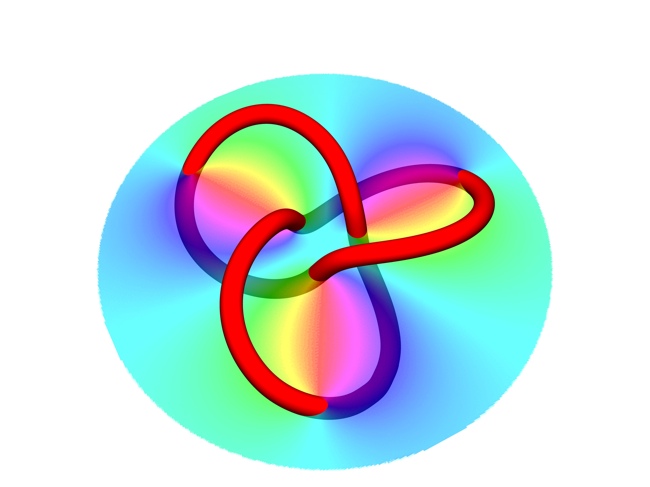Twisted Physics: Scientists Create Light Knots

Like your shoelaces or electrical cords, light can get twisted into knots. Now, scientists have used a computer-controlled hologram and theoretical physics to turn a light beam into pretzel-like shapes.
The twisted feat not only led to some pretty cool images, but the results have implications for future laser devices, the researchers say.
"In a light beam, the flow of light through space is similar to water flowing in a river," said lead researcher Mark Dennis of the University of Bristol in England. Even though the light from something like a laser pointer travels in a straight line, it can also flow in whirls and eddies, Dennis explained.
These swirls of light are called optical vortices. Along the vortices the intensity of light reaches zero, or no light.
"The light all around us is filled with these dark lines, even though we can't see them," Dennis said. "Our work actually twists dark filaments within the light beam into knots."
The researchers knew these optical vortices could be created with holograms, which direct the flow of light. By using so-called fibered knot theory, a branch of abstract mathematics inspired by everyday knots, Dennis and his colleagues created customized holograms and reflected a regular laser beam from them.
"The hologram acts like a filter for incoming light, similar to the stained glass window in a church," Dennis told LiveScience. "After going through a stained glass window, the light has taken on the pattern of colors of the window." But there's a difference: "Whilst the stained glass window manipulates color, the hologram manipulates the phase of the light wave."
Sign up for the Live Science daily newsletter now
Get the world’s most fascinating discoveries delivered straight to your inbox.
So each point on the hologram, like a small pane of window glass, changes the point of the wave's cycle in that part of the light beam. They created a hologram that would change the phase of light so that it flowed around a dark knot.
Then, the team scanned a camera through the laser field to get images of the knots. (A computer program applied before the team had created the hologram essentially made the field around the dark knot appear bright.)
Their results, detailed online Jan. 17 in the journal Nature Physics, are "firsts" for a couple of reasons. While so-called knot theorists have studied mathematical equations similar to dark knots, the new research created these knots with math functions that followed rules of propagating light. In addition, unlike other dark knots created that have been tangled up with other knots, Dennis and his colleagues produced isolated dark knots within the light beam, he said.
"For me, it shows how physicists can adapt existing pure mathematics, such as knot theory, and find it manifest in physical phenomena," Dennis said. "It also shows how finely we can control the flow and propagation of laser light using holograms. This degree of control is likely to find applications in future laser devices."
For those wanting to make their own knots, Dennis said all you would need is their hologram and a laser beam.
Jeanna Bryner is managing editor of Scientific American. Previously she was editor in chief of Live Science and, prior to that, an editor at Scholastic's Science World magazine. Bryner has an English degree from Salisbury University, a master's degree in biogeochemistry and environmental sciences from the University of Maryland and a graduate science journalism degree from New York University. She has worked as a biologist in Florida, where she monitored wetlands and did field surveys for endangered species, including the gorgeous Florida Scrub Jay. She also received an ocean sciences journalism fellowship from the Woods Hole Oceanographic Institution. She is a firm believer that science is for everyone and that just about everything can be viewed through the lens of science.









